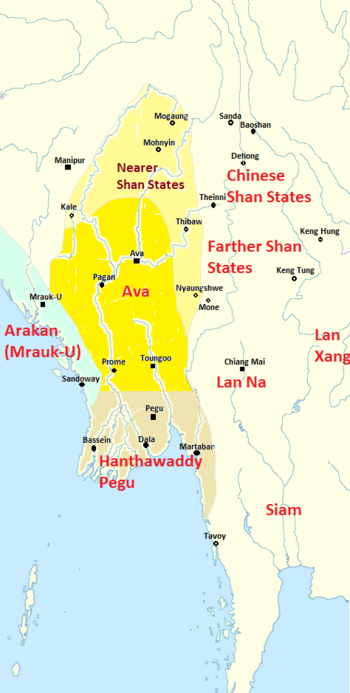مملكة آڤا
| ||||||||||||||||||||||||||||||||||||||||||||||||||||||||||||||
| ||||||||||||||||||||||||||||||||||||||||||||||||||||||||||||||
مملكة آڤا (بالبورمية: အင်းဝခေတ်, تـُنطق [ʔɪ́ɴwa̰ kʰɪʔ]؛ إنگليزية: Ava Kingdom) كانت المملكة المسيطرة التي حكمت بورما العليا (ميانمار) من 1364 حتى 1555. Founded in 1364, the kingdom was the successor state to the petty kingdoms of Myinsaing, Pinya and Sagaing التي حكمت وسط بورما منذ انهيار مملكة پگان في أواخر القرن 13.
Like the small kingdoms that preceded it, Ava was led by Bamarised Shan kings who claimed descent from the kings of Pagan.[1][2]
التاريخ
The kingdom was founded by Thado Minbya in 1364[3] following the collapse of the Sagaing and Pinya Kingdoms due to raids by the Shan States to the north. In its first years of existence, Ava, which viewed itself as the rightful successor to the Pagan Kingdom, tried to reassemble the former empire by waging constant wars against the Mon Hanthawaddy Kingdom in the south, the Shan States in the north and east, and Rakhine State in the west.[1]
While it was able to hold Taungoo and some peripheral Shan States (Kalaymyo, Mohnyin, Mogaung and Hsipaw) within its fold at the peak of its power, Ava failed to reconquer the rest. The Forty Years' War (1385–1424) with Hanthawaddy left Ava exhausted. From the 1420s to early 1480s, Ava regularly faced rebellions in its vassal regions whenever a new king came to power. In the 1480s and 1490s, the Prome Kingdom in the south and the Shan states under Ava sway in the north broke away, and Taungoo became as powerful as its nominal overlord Ava. In 1510, Taungoo also broke away.[1]
Ava was under intensified Shan raids for the first quarter of the 16th century. In 1527, the Confederation of Shan States, led by the state of Mohnyin in alliance with Prome, sacked Ava. The Confederation placed nominal kings on the Ava throne and ruled much of Upper Burma. As Prome was in alliance with the Confederation, only the tiny Taungoo in the southeastern corner, east of the Bago Yoma mountain range remained as the last holdout of independent Bamar people.
The Confederation's failure to snuff out Taungoo proved costly. Surrounded by hostile kingdoms, Taungoo took the initiative to consolidate its position, and defeated a much stronger Hanthawaddy in 1534–1541. When Taungoo turned against Prome, the Shans belatedly sent in their armies. Taungoo took Prome in 1542 and Bagan, just below Ava, in 1544.[4] In January 1555, King Bayinnaung of Taungoo conquered Ava, ending the city's role as the capital of Upper Burma for nearly two centuries.
انظر أيضاً
| هذه المقالة تحتوي على كتابة بورمية. بدون دعم العرض المناصب، فقد ترى علامات استفهام، مربعات، أو رموز أخرى بدلاً من الحروف البورمية. |
المراجع
- ^ أ ب ت Htin Aung 1967: 84–103
- ^ Phayre 1883: 63–75
- ^ Coedès, George (1968). Walter F. Vella (ed.). The Indianized States of Southeast Asia. trans.Susan Brown Cowing. University of Hawaii Press. ISBN 978-0-8248-0368-1.
- ^ Phayre 1883: 100–101
ببليوگرافيا
- Harvey, G. E. (1925). History of Burma: From the Earliest Times to 10 March 1824. London: Frank Cass & Co. Ltd.
- Htin Aung, Maung (1967). A History of Burma. New York and London: Cambridge University Press.
- Phayre, Lt. Gen. Sir Arthur P. (1883). History of Burma (1967 ed.). London: Susil Gupta.
- Former country articles categorised by government type
- Articles containing بورمية-language text
- Articles containing إنگليزية-language text
- Pages using Lang-xx templates
- Myanmar articles missing geocoordinate data
- All articles needing coordinates
- أسرة آڤا
- Burmese monarchy
- Former countries in Southeast Asia
- ملكيات سابقة في آسيا
- القرن 14 في بورما
- القرن 15 في بورما
- القرن 16 في بورما
- دول وأقاليم تأسست في 1364
- States and territories disestablished in 1555
- 1364 establishments in Asia
- 1550s disestablishments in Asia
- 14th-century establishments in Burma
- Former monarchies of Southeast Asia


